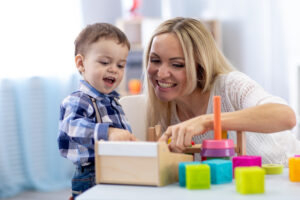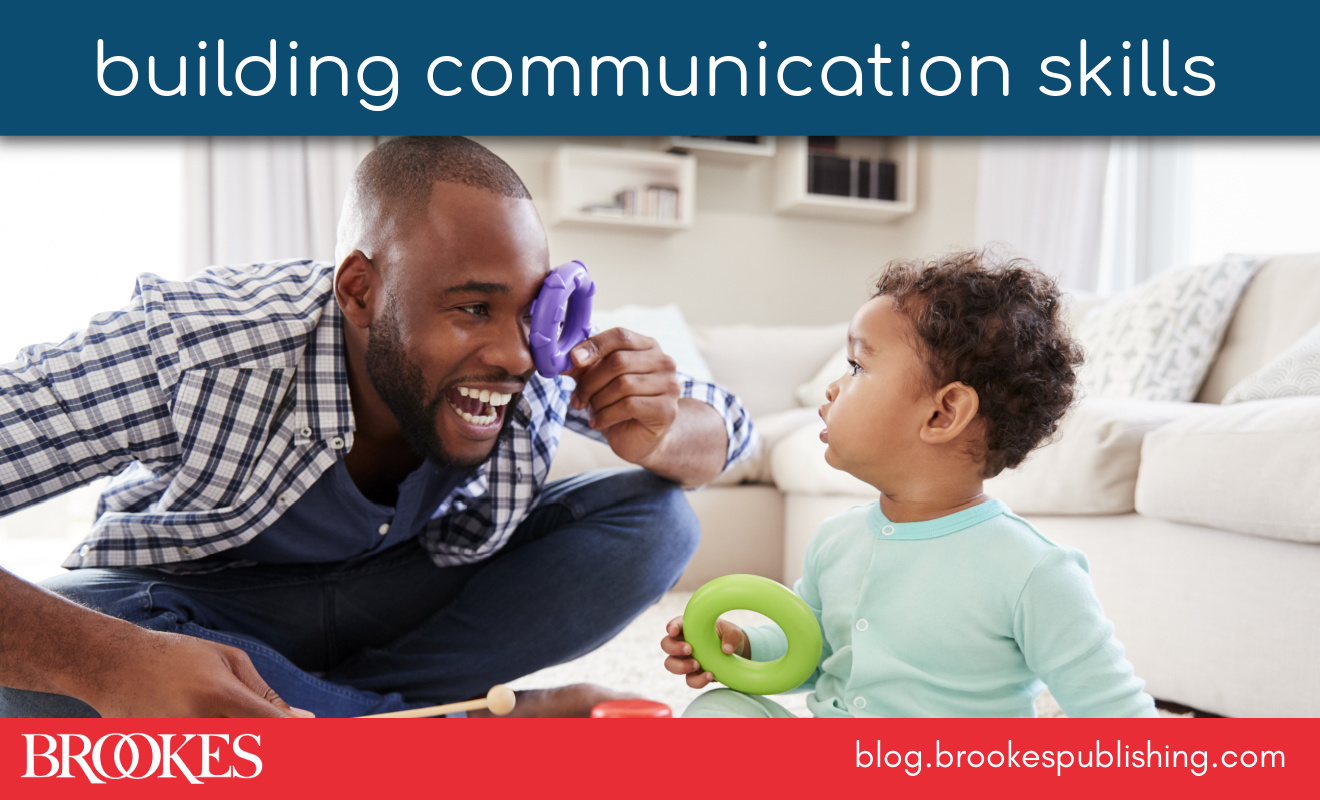 In the critical first few years of a child’s life, adults help lay a foundation for communication and language skills through games and activities that encourage talk and build on a child’s early utterances. Today’s post brings you 14 simple things that adults can do with very young children to nurture their early communication and learn new language skills. Excerpted and adapted from four of our practical resources on early intervention and development (see the end for credits), this is a great post to share with parents and other caregivers as they prepare young children to be successful communicators and readers.
In the critical first few years of a child’s life, adults help lay a foundation for communication and language skills through games and activities that encourage talk and build on a child’s early utterances. Today’s post brings you 14 simple things that adults can do with very young children to nurture their early communication and learn new language skills. Excerpted and adapted from four of our practical resources on early intervention and development (see the end for credits), this is a great post to share with parents and other caregivers as they prepare young children to be successful communicators and readers.
 Encourage choice-making. Offering choices between items can boost a child’s motivation to communicate. Hold up bath toys and ask the child: “Do you want the duck or the boat?” While getting the child dressed, give choices of clothing items, where to get dressed, or what to put on first. At snack time, offer choices of foods and beverages when appropriate. Giving word choices is helpful for children who have difficulty recalling the words needed. For example, saying “which one?” might make it more difficult for the child to retrieve the word and/or sounds that go with the choice, but saying “Milk? Juice?” provides a word model to facilitate imitation.
Encourage choice-making. Offering choices between items can boost a child’s motivation to communicate. Hold up bath toys and ask the child: “Do you want the duck or the boat?” While getting the child dressed, give choices of clothing items, where to get dressed, or what to put on first. At snack time, offer choices of foods and beverages when appropriate. Giving word choices is helpful for children who have difficulty recalling the words needed. For example, saying “which one?” might make it more difficult for the child to retrieve the word and/or sounds that go with the choice, but saying “Milk? Juice?” provides a word model to facilitate imitation.
Reinforce word approximations. Throughout the day, you might notice times when children are approximating a word: for example, trying to say “car” by saying “da.” Encourage the child by saying “Yes! Car!” so that the word approximation is reinforced. If the child points to cheese and says “dee,” comment as if she said “cheese” appropriately by saying, “Cheese! I love cheese too.” Model the word cheese slowly and clearly, slightly emphasizing the /ch/ and the end sound.
 Label items during errands. Pointing at favorite foods in the grocery store and naming the items provides a simple model that the child can imitate when ready. When you’re shopping at a store for household goods, stopping in the toy aisle will provide especially high motivation for labeling and naming.
Label items during errands. Pointing at favorite foods in the grocery store and naming the items provides a simple model that the child can imitate when ready. When you’re shopping at a store for household goods, stopping in the toy aisle will provide especially high motivation for labeling and naming.
Build on their words. Systematic expansions can help build sentences with grammar and syntax. When a child says one word, add one more (e.g., if the child says “cookie,” say “Want cookie. Sure you can have a cookie.”). When the child uses two-word sentences, model three-word sentences. Add small grammar pieces to the child’s sentences, such as prepositions, a plural /s/, an a, the, or ing. If the child says “kitty chair,” for example, you can model “kitty on chair.”
 Use action words. To expand the number of verbs in a child’s vocabulary, tell the child what you are doing throughout the day using a variety of action words (e.g., “I am brushing my hair. Would you like to brush your hair?”). Play games using action words by asking the child to jump, run, reach, climb, roll, and so forth. When reading to a child, discuss the action of the characters in the book and invite the child to repeat the verbs after you. You could also ask him to find the character that is carrying out different actions.
Use action words. To expand the number of verbs in a child’s vocabulary, tell the child what you are doing throughout the day using a variety of action words (e.g., “I am brushing my hair. Would you like to brush your hair?”). Play games using action words by asking the child to jump, run, reach, climb, roll, and so forth. When reading to a child, discuss the action of the characters in the book and invite the child to repeat the verbs after you. You could also ask him to find the character that is carrying out different actions.
Make flash cards to encourage naming. Increase a child’s understanding of representations by making a set of cards displaying pictures of simple household objects or things in a child’s world. Laminate the cards and place them in a basket. Remove each card from the basket one by one, name each picture, and invite the child to repeat the name after you. After completing this experience, point to each
card and ask the child to tell you, “What’s this?”
 Use rhymes and songs to reinforce language. Choose two to three nursery rhymes or songs that you and the child enjoy. During the day, recite or sing one or more of these with the child. When the child becomes more familiar with each rhyme or song, encourage her independence by saying the first lines and letting her finish, adding support whenever needed. When the child recites a rhyme or sings a song by herself, celebrate!
Use rhymes and songs to reinforce language. Choose two to three nursery rhymes or songs that you and the child enjoy. During the day, recite or sing one or more of these with the child. When the child becomes more familiar with each rhyme or song, encourage her independence by saying the first lines and letting her finish, adding support whenever needed. When the child recites a rhyme or sings a song by herself, celebrate!
Write and read notes to your child. Put little notes to your child here and there throughout the house. A note might say, “You are a very helpful brother to your baby sister.” A note on your child’s toy shelf can say you noticed that the toys were put away. A note by the plate at dinnertime can say that Dad will read a favorite story at bedtime. Read these notes out loud to your child so he learns that reading is fun and important.
 Tune in to and talk about sounds. Turn off the TV and other electronics, and listen with the child to sounds around your home. Listen to the refrigerator motor, wind chimes, a clock ticking, or people talking. Ask the child to tell you what she hears. Try this at night—listen for the night sounds of crickets, frogs, or cars beeping, and whisper to each other about what you hear.
Tune in to and talk about sounds. Turn off the TV and other electronics, and listen with the child to sounds around your home. Listen to the refrigerator motor, wind chimes, a clock ticking, or people talking. Ask the child to tell you what she hears. Try this at night—listen for the night sounds of crickets, frogs, or cars beeping, and whisper to each other about what you hear.
Play naming games. As you ride the bus or drive in your car, ask your child to help you look for things in a certain category. Together, find and name things with wheels, things that are tall, or things of different colors. Choose the category ahead of time or let your child pick. You might say, “Let’s see how many animals we see.” You and your child can point out live animals or animals on signs or billboards.
Ask questions. Posing questions to young children is a great way to build early language skills. Start with simple questions when children are very young (e.g., “What color is that?”), and then as they get a little older, ask questions that go beyond quizzing and really engage thinking and curiosity:
- “Why do you think your friend is crying? How can we help him feel better?”
- “Why do you think it gets dark at night?”
- “What do we need for our tea party?”
- “Who did you play with at child care today? What did you do together?”
- “How do you think we can make this toy go?”
- “That looks like some sort of seed pod. Where did you find it? Do you think it came from a tree?”
 Make the most of pretend play. Look for ways to infuse a child’s pretend play with communication opportunities. Call the child on a pretend telephone and have a conversation. Ask a question or make a comment that helps children put words to their play: “Oh, no. Snoopy fell down. Did he hurt his knee? Does he need a Band-Aid?” Try taking on a subordinate role in play: be the baby, patient, passenger, or customer, and let a child care for, boss, or serve you. As you play your role, encourage the child to do most of the talking.
Make the most of pretend play. Look for ways to infuse a child’s pretend play with communication opportunities. Call the child on a pretend telephone and have a conversation. Ask a question or make a comment that helps children put words to their play: “Oh, no. Snoopy fell down. Did he hurt his knee? Does he need a Band-Aid?” Try taking on a subordinate role in play: be the baby, patient, passenger, or customer, and let a child care for, boss, or serve you. As you play your role, encourage the child to do most of the talking.
Take them for a checkup. It’s always a good idea to ensure that no medical issues, such as fluid in the ears or a hearing loss, interfere with speech development. Be sure that these issues are addressed at regular doctor visits; investigating possible medical contributions will help determine if health issues may be a factor in speech development.
What’s your favorite thing to do with young children to nurture their communication skills? Share what works for you in the comments below—and for many more tips and ideas on promoting early communication and language skills, check out the books behind today’s post:
Tips 1-5 and 14 from Early Intervention Every Day! by Merle J. Crawford & Barbara Weber
Tips 6-8 from Beautiful Beginnings by Helen Raikes & Jane McCall Whitmer
Tips 9-11 from ASQ®:SE-2 Learning Activities by Elizabeth Twombly, Leslie Munson, and Lois Pribble
Tips 12 & 13 from Talk to Me, Baby! by Betty Bardige
Stay up to date on the latest posts, news, strategies, and more!
Sign up for one of our FREE newslettersMore posts like this

15 Recommended Resources for Getting Language and Literacy Skills On Track
September 23, 2021
11 Language-Boosting Activities for Young Children
April 10, 2019


Write a Comment
Your email address will not be published. Required fields are marked *
Post a Comment